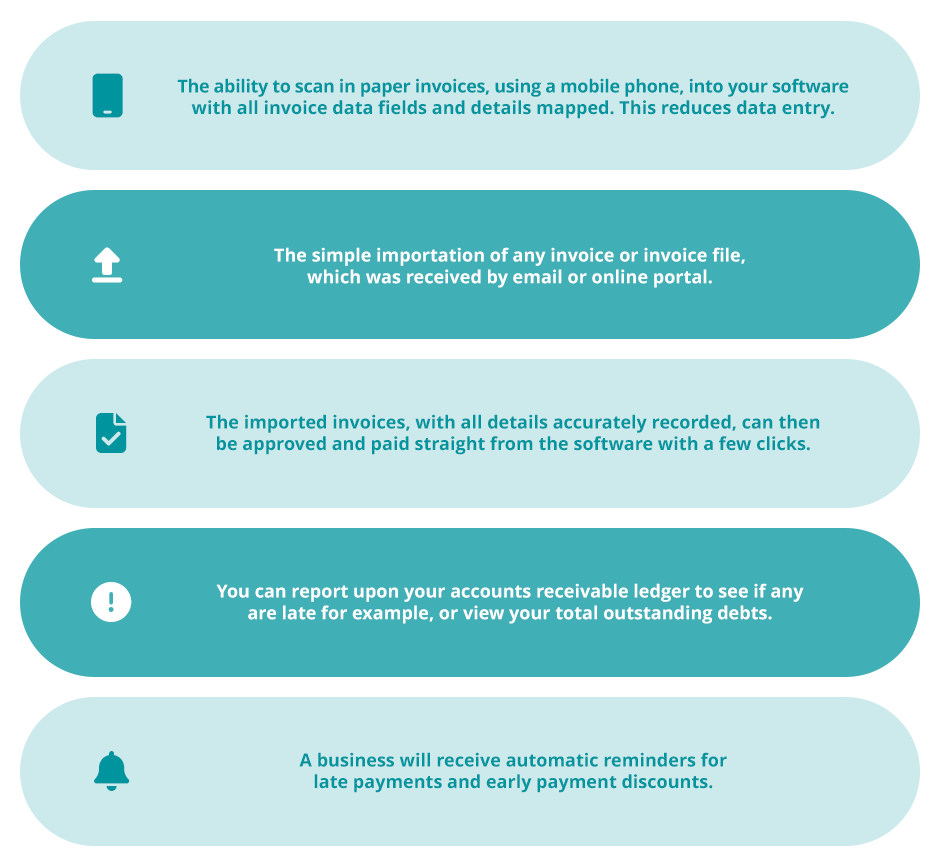TABLE OF CONTENTS
- What is an accounts payable ledger?
- What’s accounts payable automation?
- What’s accounts payable automation software?
- Integrating accounts payable software with accounting software
- Why would businesses seek to automate their accounts payable?
- The perils of mismanaged or manual invoice payment
- How can you offer accounts payable automation as a bookkeeper?
By advising your clients on accounts payable processes (and urging them to use proper accounts payable automation software) you’ll provide significant value; not only will you free up their time you’ll also automate a frustrating yet necessary workflow for them.
What is an accounts payable ledger?
Accounts payable, or an accounts payable ledger, is a record of a business’s unpaid invoices. A business’s accounts payable is essentially a record of their business debts, in the form of invoices.
Immediately upon receiving an invoice, businesses usually record and update their accounts payable ledger (often within their accounting software). For accounting and bookkeeping purposes, your AP is viewed as ‘expenses’ which feed into other types of reports such as balance sheets and financial statements. Indeed, it’s important to understand that if a business has a large accounts payable ledger, it should be viewed as a liability.
While big companies often have a dedicated accounts payable department in-house, most small businesses manage invoice processing themselves.
What’s accounts payable automation?
Historically, paying invoices and managing an accounts payable ledger are manual-heavy processes. When a business receives an invoice, whether by mail, email or through eInvoicing, they have to process the payment and keep a record.
However, when you automate accounts payable processes, those invoices which are imported or scanned into software, are easily paid, managed, and reported upon.
What’s accounts payable automation software?
Accounts payable automation software works by compiling invoices in a solution ready for prompt and easy payment. Regardless of whether a business receives an invoice by mail, email, or an online portal, with fit-for-purpose technology, invoices can be swiftly and accurately imported, then paid and easily reported upon.
Common features of accounts payable automation software include:
- The ability to scan paper invoices into your software using a mobile phone (with all data fields and details mapped). This reduces data entry.
- Simple importation of any invoice or invoice file, which was originally received by email or an online portal.
- The imported invoices, with all details accurately recorded, can then be approved, and paid straight from the software, in a few clicks.
- The function to report upon your accounts receivable ledger, for example, to see if any payments are late, or to view your total outstanding debts.
- A business will receive automatic reminders for late payments and early payment discounts.
Integrating accounts payable software with accounting software
It’s likely your business client already has cloud accounting software, or perhaps you manage this for them.
By integrating accounts payable software with accounting software, cash flow is easily tracked, bank reconciliation is simple and accurate, and financial reporting – such as general ledger, cash flow reports, balance sheets et cetera – are up-to-date.
This is why a good bookkeeper will advise on not only accounts payable software, but also accounting software and the best way to integrate them to create an efficient workflow.

Why would businesses seek to automate their accounts payable?
In terms of maximising value for your business client, there are significant benefits to them up taking accounts payable software, especially if they receive high volumes of invoices.
- Error reduction
By using software to import or scan invoice data, a business avoids any human error (avoiding overall, a highly error prone data entry process). When keying in important details such as payment amounts, due dates, and supplier details with automation software, these will be recorded swiftly and accurately.
- Prompt payments
Paying invoices promptly is immensely important. By opting for software with built-in payment reminders, you can radically reduce any incidence of late payments.
- Streamlined workflow
In a common and vital workflow like making invoice payments, reducing the number of steps involved along with manual processes, is critical. If you and your small business clients opt for purpose-built software, you can streamline a formerly cumbersome and inefficient process. Indeed a swift invoice approval process will free your business clients up for more important work, while giving them peace of mind that their invoices are up to date.
- Better overview of cash position
If a client manages their accounts payable by integrating automation software with their accounting solution, it’s possible to encourage exceptional and current cash flow reporting. Automating accounts payable grants the business oversight of their true financial position at any given time (especially when it comes to expense management).
- Better security
By using accounts payable automation software to import and pay invoices, you reduce the instance of fraud and cybercrime. By paying securely and ensuring that invoices are legitimate and correct, a client can protect themselves from cybercrime.
The perils of mismanaged or manual invoice payment
Now what are the possible negative outcomes if your client is using manual processes, or makes mistakes in the management of their accounts payable?
- Missed payments, penalties, and loss of trust
If a payment is missed, or late, there are several ramifications. Firstly, it can attract expensive and unnecessary penalties. Secondly, a client can dud a supplier and create inaccurate cash flow perceptions. Thirdly, they may lose trust in their supplier leading to fractured relationships.
- Inaccurate financial reporting
If accounts payable is not automated, and data is not up to date or flowing into accounting software, it’s difficult to determine a businesses’ true financial position and cash flow.
- Miss out on early payment discounts
Many suppliers offer discounts for early payment. If you don’t have automated alerts set up via your software, you may miss out on these discounts.
- Confusing, error-prone and cumbersome workflows
If a business manages its payments and accounts receivable ledger manually, it creates a real headache in terms of time (not to mention the admin burden.) It also leads to easily-avoided mistakes which can be costly and stressful.
How can you offer accounts payable automation as a bookkeeper?
As a bookkeeper, who likely already has a list of clients using accounting software, you can provide additional advisory services around the uptake and use of accounts payable automation software.
- You can provide advice around which programs to use and what they’ll do for them.
- Make suggestions around how your clients can best integrate accounts payable software with their existing accounting software.
- Lead your client through the best and most efficient workflow to manage the whole invoice payment and reporting process.
- For some clients, you may offer to manage the entire accounts payable process on their behalf.
Whichever bookkeeping and business advisory services you offer, in providing invoicing guidance, your clients will reap a raft of valuable benefits.

